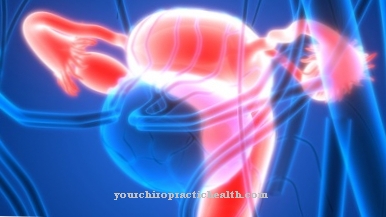Of the migrating motor complex is a movement pattern of the digestive tract that guides the ingested food through the stomach.
The muscles of the stomach and small intestine move under the control of the enteric nervous system to move food through the digestive tract.
Diseases like diabetes can paralyze this movement pattern.
What is the migratory motor complex?

Medicine understands the migrating motor complex as a recurring pattern of activity in the stomach and small intestine. The movement pattern is indispensable for a functioning digestion on a full stomach, as this is how the food reaches the intestines. In an empty state, however, this type of movement is responsible for phenomena such as stomach growling.
In the stomach, the migrating motor complex takes around 90 minutes to two hours and has a three-phase course. Little happens in the first phase. There are neither mechanical activities nor secretions. During the second phase, slight uncontrolled contractions of the stomach take place. In the third phase, strong stomach contractions take place, which completely empty the stomach and push the contents into the intestines.
When the stomach is empty, the air in the stomach is compressed during this phase. The contractions of the empty stomach are also known as starvation contractions. In medical terminology, this phenomenon is called borborygmus.
Function & task
In the stomach, solid food is kneaded by stomach contractions and also broken down with gastric juice. The contractions of the stomach are controlled by the autonomic nervous system, which coordinates all vital vital functions. In addition to the digestive movements, the heartbeat and breathing are also controlled from here.
The digestive nervous system is also called the enteric nervous system and is an independent sub-form of the autonomic nervous system that receives signals from the sympathetic and parasympathetic nervous systems.
Partly digested food reaches the duodenum via the stomach contractions under the control of the enteric nervous system, where digestive enzymes do their work.
To get the digested food into the duodenum at all, the muscles of the stomach have to work hard. Contractions of these muscles allow food to be transported. The stomach walls contract during this cyclical movement pattern and move towards the intestines. This movement pushes food into the intestines when the stomach is full. This movement towards the intestines is equivalent to stroking the stomach and is essential for the digestive system to function properly.
When the stomach is empty, it cannot interrupt the schematic movement pattern, although no food should actually be transported. The contractions of the empty stomach cause the stomach muscles to move a mixture of air and gastric juice instead of food. This is responsible for the growling stomach. The fact that it is audible at all is due to the large volume of the resonance body. Most researchers assume that the sound of the stomach growling is actually intended to encourage food to be consumed.
The movement complex of the stomach in the form of the three phases of immobility, slight movement and strong contraction is repeated at intervals of around one and a half to three hours. Each repetition is principally intended to empty the stomach.
The migrating motor complex takes place not only in the stomach but also in the small intestine. The muscles of the small intestine move in waves at regular intervals in order to transport the intestinal contents into the large intestine. Since the movement pattern also takes place in the small intestine via the vegetative or enteric nervous system, it is not tied to food intake here either.
You can find your medication here
➔ Medication for diarrheaIllnesses & ailments
In the case of paralysis of the stomach or small intestine muscles, the migrating motor complex in the affected digestive organ no longer takes place or takes place only slowly. In chronic gastric paralysis, for example, the repetition of the movement pattern is delayed. The gastric emptying takes longer than the average. As a result, those affected feel a persistent feeling of fullness, nausea or upper abdominal pain.
Chronic stomach paralysis is often related to diseases such as diabetes, but viral infections and damage to the muscles are also possible causes. In diabetes, the nerves of the stomach or small intestine themselves are affected by the functional impairment and cannot receive commands from the brain, or only receive them at a slower rate.
Persistent disturbances in gastric emptying can expand the stomach to an unnatural volume. Acute paralysis of the two digestive organs must be distinguished from chronic gastric or small intestinal paralysis. In the case of acute paralysis, no more movement is possible. The migrating motor complex is completely eliminated and the organ rests permanently.
Acute paralysis of the digestive system can occur, for example, in the context of paraplegia. Diseases such as Hirschsprung's disease can also be responsible for enteric paralysis. Diseases such as multiple sclerosis or ALS, on the other hand, usually do not interfere with the autonomic nervous system.













.jpg)

.jpg)
.jpg)











.jpg)